最新广东版开心学英语小学 Book 2 Unit 3 教案及练习
- 格式:doc
- 大小:730.00 KB
- 文档页数:20
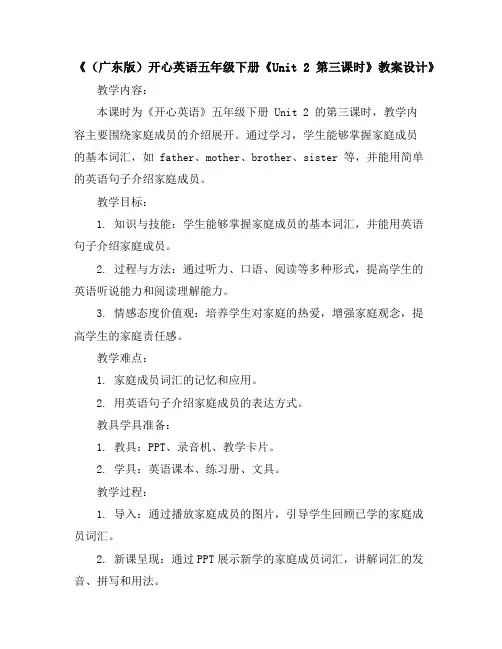
《(广东版)开心英语五年级下册《Unit 2 第三课时》教案设计》教学内容:本课时为《开心英语》五年级下册 Unit 2 的第三课时,教学内容主要围绕家庭成员的介绍展开。
通过学习,学生能够掌握家庭成员的基本词汇,如 father、mother、brother、sister 等,并能用简单的英语句子介绍家庭成员。
教学目标:1. 知识与技能:学生能够掌握家庭成员的基本词汇,并能用英语句子介绍家庭成员。
2. 过程与方法:通过听力、口语、阅读等多种形式,提高学生的英语听说能力和阅读理解能力。
3. 情感态度价值观:培养学生对家庭的热爱,增强家庭观念,提高学生的家庭责任感。
教学难点:1. 家庭成员词汇的记忆和应用。
2. 用英语句子介绍家庭成员的表达方式。
教具学具准备:1. 教具:PPT、录音机、教学卡片。
2. 学具:英语课本、练习册、文具。
教学过程:1. 导入:通过播放家庭成员的图片,引导学生回顾已学的家庭成员词汇。
2. 新课呈现:通过PPT展示新学的家庭成员词汇,讲解词汇的发音、拼写和用法。
3. 操练:通过听力练习、口语练习、阅读练习等多种形式,巩固学生对家庭成员词汇的掌握。
4. 应用:学生分组进行角色扮演,用英语句子介绍家庭成员。
6. 作业布置:布置相关的练习题,巩固所学内容。
板书设计:1. 《开心英语》五年级下册 Unit 2 第三课时2. 主要内容:家庭成员词汇、用英语句子介绍家庭成员。
作业设计:1. 完成练习册上的相关练习题。
2. 用英语句子介绍自己的家庭成员,写下来。
课后反思:通过本节课的教学,我发现学生在家庭成员词汇的掌握上还有一定的困难,需要加强记忆和应用。
在用英语句子介绍家庭成员的表达方式上,学生还存在一些问题,需要多加练习。
在今后的教学中,我将注重学生的个体差异,因材施教,提高教学效果。
总的来说,本节课的教学目标基本达成,学生的英语听说能力和阅读理解能力得到了提高,对家庭的热爱和家庭责任感也有所增强。
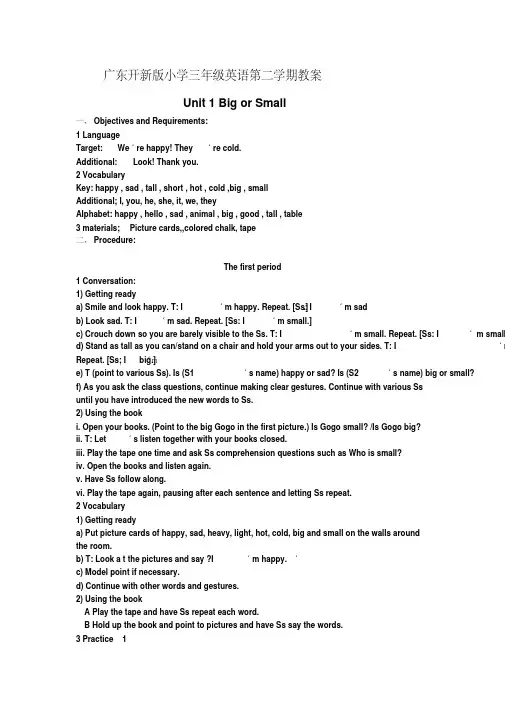
广东开新版小学三年级英语第二学期教案Unit 1 Big or Small一、Objectives and Requirements:1 LanguageTarget: We‘re happy! They‘re cold.Additional: Look! Thank you.2 VocabularyKey: happy , sad , tall , short , hot , cold ,big , smallAdditional; I, you, he, she, it, we, theyAlphabet: happy , hello , sad , animal , big , good , tall , table3 materials; Picture cards,,colored chalk, tape二、Procedure:The first period1 Conversation:1) Getting ready.]a) Smile and look happy. T: I‘m happy. Repeat. [Ss: I‘m sadb) Look sad. T: I‘m sad. Repeat. [Ss: I‘m small.]c) Crouch down so you are barely visible to the Ss. T: I‘m small. Repeat. [Ss: I‘ m smalld) Stand as tall as you can/stand on a chair and hold your arms out to your sides. T: I‘mbig.]Repeat. [Ss; I‘me) T (point to various Ss). Is (S1‘s name) happy or sad? Is (S2‘s name) big or small?f) As you ask the class questions, continue making clear gestures. Continue with various Ssuntil you have introduced the new words to Ss.2) Using the booki. Open your books. (Point to the big Gogo in the first picture.) Is Gogo small? /Is Gogo big?ii. T: Let‘s listen together with your books closed.iii. Play the tape one time and ask Ss comprehension questions such as Who is small?iv. Open the books and listen again.v. Have Ss follow along.vi. Play the tape again, pausing after each sentence and letting Ss repeat.2 Vocabulary1) Getting readya) Put picture cards of happy, sad, heavy, light, hot, cold, big and small on the walls aroundthe room.b) T: Look a t the pictures and say ?I‘m happy.‘c) Model point if necessary.d) Continue with other words and gestures.2) Using the bookA Play the tape and have Ss repeat each word.B Hold up the book and point to pictures and have Ss say the words.3 Practice 11) Getting readyi. Point to the pictures one at a time .and ask Ss questions about it.ii. Elicit responses and do the same for the other three pictures.iii. Have Ss guess what the dialogs are going to be.2) Using the booki. Play the tape for number1, then pause.ii. While Ss are responding, gradually move your hand to picture Ciii. Continue, pausing after each question to allow Ss to answer on their own.4 Practice21) Getting readyi. Walk around the room asking Ss questions. Move around the room and ask questionsquickly to keep Ss focused.ii. T:Are you cold? Are you sad?iii. Elicit responses and encourage Ss to ask you this question with the unit‘s vocabulary words..2) Using the booka) Play the tape and have Ss answer.b) Model complete sentences.C) Put Ss in pairs to ask and answer these questions.教学后记:1、在教新单词的过程中,对各个单词都配以相应的动作教学,学生学习积极性很高,而且大部分学生很快就掌握了该课单词的发音。
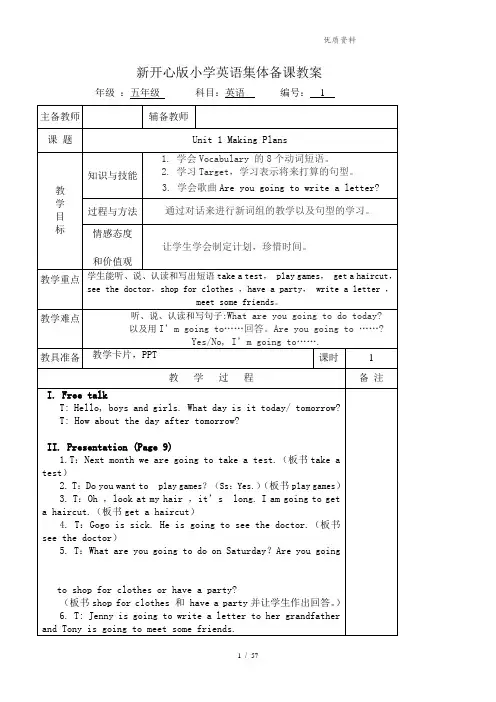
新开心版小学英语集体备课教案年级:五年级科目:英语编号: 1新开心版小学英语集体备课教案年级 :五年级科目:英语 编号: 2新开心版小学英语集体备课教案年级:五年级科目:英语编号: 3新开心版小学英语集体备课教案年级:五年级科目:英语编号: 4新开心版小学英语集体备课教案年级:五年级科目:英语编号: 5新开心版小学英语集体备课教案年级:五年级科目:英语编号: 6新开心版小学英语集体备课教案年级:五年级科目:英语编号:7新开心版小学英语集体备课教案年级:五年级科目:英语编号:8新开心版小学英语集体备课教案年级:五年级科目:英语编号:9新开心版小学英语集体备课教案年级:五年级科目:英语编号:10新开心版小学英语集体备课教案年级:五年级科目:英语编号:11新开心版小学英语集体备课教案年级:五年级科目:英语编号:12新开心版小学英语集体备课教案年级:五年级科目:英语编号:13新开心版小学英语集体备课教案年级:五年级科目:英语编号:14新开心版小学英语集体备课教案年级:五年级科目:英语编号:15新开心版小学英语集体备课教案年级:五年级科目:英语编号:16新开心版小学英语集体备课教案年级:五年级科目:英语编号:17新开心版小学英语集体备课教案年级:五年级科目:英语编号:18新开心版小学英语集体备课教案年级:五年级科目:英语编号:19新开心版小学英语集体备课教案年级:五年级科目:英语编号:20新开心版小学英语集体备课教案年级:五年级科目:英语编号:21新开心版小学英语集体备课教案年级:五年级科目:英语编号:22新开心版小学英语集体备课教案年级:五年级科目:英语编号:23新开心版小学英语集体备课教案年级:五年级科目:英语编号:24新开心版小学英语集体备课教案年级:五年级科目:英语编号:25新开心版小学英语集体备课教案年级:五年级科目:英语编号:26新开心版小学英语集体备课教案年级:五年级科目:英语编号:27。
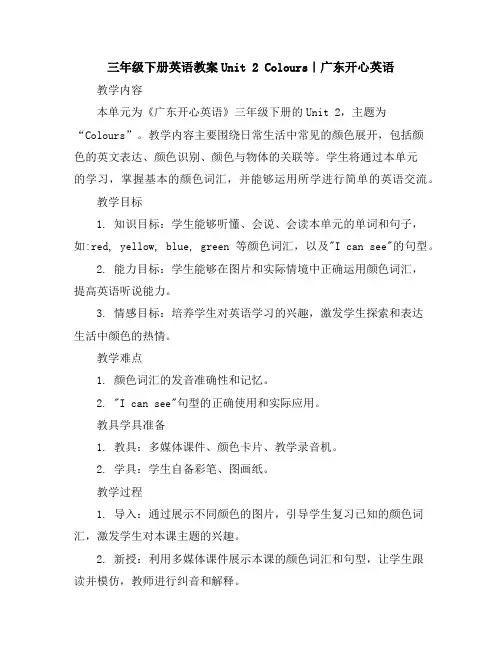
三年级下册英语教案Unit 2 Colours|广东开心英语教学内容本单元为《广东开心英语》三年级下册的Unit 2,主题为“Colours”。
教学内容主要围绕日常生活中常见的颜色展开,包括颜色的英文表达、颜色识别、颜色与物体的关联等。
学生将通过本单元的学习,掌握基本的颜色词汇,并能够运用所学进行简单的英语交流。
教学目标1. 知识目标:学生能够听懂、会说、会读本单元的单词和句子,如:red, yellow, blue, green等颜色词汇,以及"I can see"的句型。
2. 能力目标:学生能够在图片和实际情境中正确运用颜色词汇,提高英语听说能力。
3. 情感目标:培养学生对英语学习的兴趣,激发学生探索和表达生活中颜色的热情。
教学难点1. 颜色词汇的发音准确性和记忆。
2. "I can see"句型的正确使用和实际应用。
教具学具准备1. 教具:多媒体课件、颜色卡片、教学录音机。
2. 学具:学生自备彩笔、图画纸。
教学过程1. 导入:通过展示不同颜色的图片,引导学生复习已知的颜色词汇,激发学生对本课主题的兴趣。
2. 新授:利用多媒体课件展示本课的颜色词汇和句型,让学生跟读并模仿,教师进行纠音和解释。
3. 练习:学生分组进行颜色词汇的练习游戏,如“找出相同颜色的物品”等,巩固记忆。
4. 应用:学生用"I can see"句型描述自己看到的颜色,进行实际交流练习。
板书设计本课的主要颜色词汇:red, yellow, blue, green等。
重点句型:"I can see"课堂练习的示例。
作业设计1. 学生完成课后的颜色词汇练习题。
2. 学生用英文写一段关于自己喜欢颜色的短文。
课后反思课后反思将围绕学生的掌握情况、教学方法的适用性以及课堂氛围等方面进行。
教师将根据学生的反馈和学习效果,调整教学策略,以便更好地促进学生的英语学习。
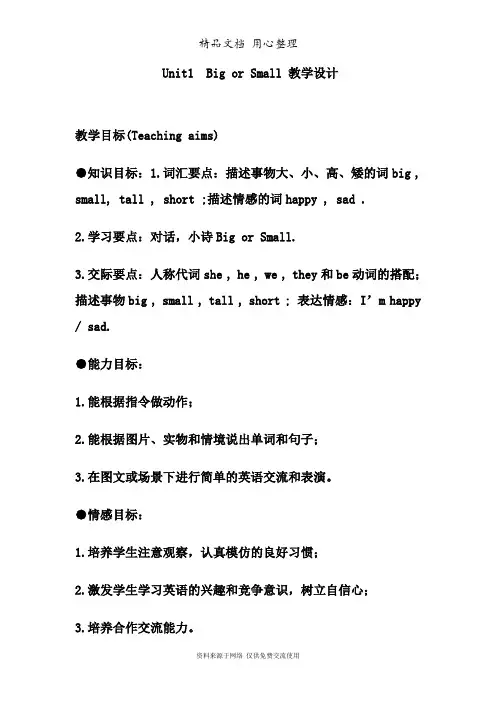
Unit1 Big or Small 教学设计教学目标(Teaching aims)●知识目标:1.词汇要点:描述事物大、小、高、矮的词big , small, tall , short ;描述情感的词happy , sad .2.学习要点:对话,小诗Big or Small.3.交际要点:人称代词she , he , we , they和be动词的搭配;描述事物big , small , tall , short ; 表达情感:I’m happy / sad.●能力目标:1.能根据指令做动作;2.能根据图片、实物和情境说出单词和句子;3.在图文或场景下进行简单的英语交流和表演。
●情感目标:1.培养学生注意观察,认真模仿的良好习惯;2.激发学生学习英语的兴趣和竞争意识,树立自信心;3.培养合作交流能力。
教学过程:I: Warm-up and review·Greetings 增进师生间的感情。
· Let’s sing (展示课件:歌曲“Glad to Meet You”)让学生在轻松愉快的氛围中进入新课学习。
· Review 1)Review the animals .(fox,ducking,tadpoleBabyBear ,lion)T:Look!What’ s it? Ps:It’s a …2) Review the colour words (展示课件,奥运五环)T: What colour are they ? 复习所学动物,颜色词。
Ps: Blue,black,red,yellow,green.T: What’s it ? Ps:奥运五环图T: Yes . The Olympic ringsII. Presentation and practice .1. 创设情景,导入单词学习(1) (出示篮球和乒乓球实物道具) T:Look!What’s it?Ps: It’s a ball.T: Good! The basketball is big . The ping-pong 实物教学法更形象直观,促ball is small (板书 big , small )教读 big , small(手势辅助)进学生对词义的理解。
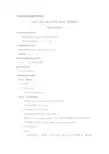
开心学英语小学英语六年级下册Unit 2 Turn left at the corner. 教学设计Period threeTeaching objectives:1.Master the words in “Sounds and words”.2.Master the sounds ﹝kr﹞﹝gr﹞.Teaching key points:New words: cream, crab, crocodile, grassSounds: ﹝kr﹞﹝gr﹞Teaching difficult points:﹝kr﹞﹝gr﹞的发音规则。
Teaching aids:recorder\ picturesTeaching procedure:Step 1 ReviewFree talk:Where’s the …?Turn left/ Turn right. It’s …Step 2 Presentation1.Teacher shows a picture and asks: What’s this?引导学生回答:It’s a crab.2.Teach the sounds of “crab”.The same teaching “cream, crocodile”.3.总结出“cream, crab, crocodile”这几个单词的前两个字母的共同发音。
以同样的方法学习“grass, grapes , grocery, grocery store”4.Listen and say.5.Game:给学生朗读一个故事,故事中含有一些以cr,gr开头的单词。
教师读第一遍时,学生只是听,读第二遍时,学生要准备两张卡片,一张代表cr,另一张代表gr,告诉学生在听到含有其中一个读音的单词时,便举起相应的卡片。
Step 3 Listen and chant1.Listen to the chant once.2.Teach the new words in the chant.3.Read after the tape .4.Game:学生比赛,看谁读得又快又准。
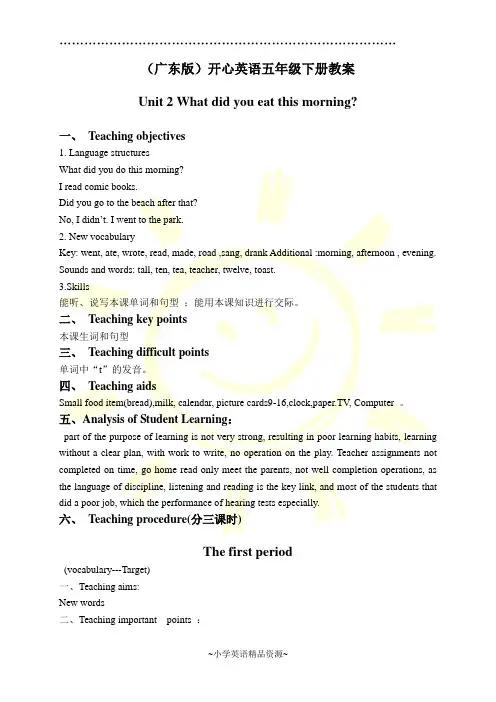
(广东版)开心英语五年级下册教案Unit 2 What did you eat this morning?一、Teaching objectives1. Language structuresWhat did you do this morning?I read comic books.Did you go to the beach after that?No, I didn’t. I went to the park.2. New vocabularyKey: went, ate, wrote, read, made, road ,sang, drank Additional :morning, afternoon , evening. Sounds and words: tall, ten, tea, teacher, twelve, toast.3.Skills能听、说写本课单词和句型;能用本课知识进行交际。
二、Teaching key points本课生词和句型三、Teaching difficult points单词中“t”的发音。
四、Teaching aidsSmall food item(bread),milk, calendar, picture cards9-16,clock,, Computer 。
五、Analysis of Student Learning:part of the purpose of learning is not very strong, resulting in poor learning habits, learning without a clear plan, with work to write, no operation on the play. Teacher assignments not completed on time, go home read only meet the parents, not well completion operations, as the language of discipline, listening and reading is the key link, and most of the students that did a poor job, which the performance of hearing tests especially.六、Teaching procedure(分三课时)The first period(vocabulary---Target)一、Teaching aims:New words二、Teaching important points :New words三、Teaching difficult points:New words四、Teaching material:tape, computer, objects.五、Teaching methods、Learning methods:GameTeaching Comprehension:一、Revision1. Where were you yesterday?2. What was the food like in Modonald’s?3. Where were you during the winter holiday?二、Presentation1) New wordsT: I’m drinking some milk. (边做边说)T: (举起空杯子) I drank some milk .板书:drink→drinking→drank.把面包放进嘴巴食。
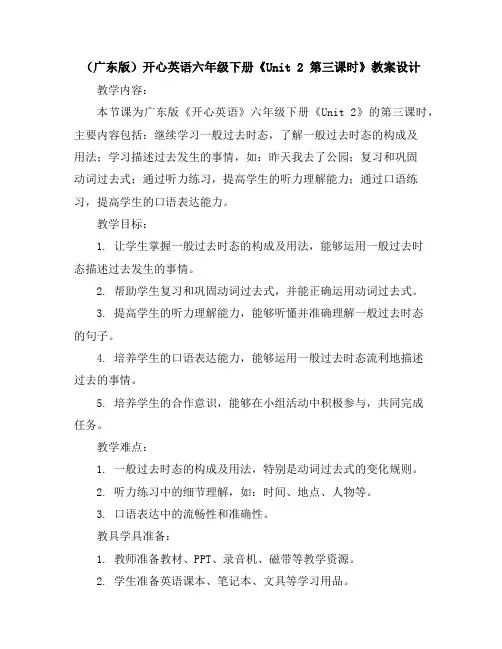
(广东版)开心英语六年级下册《Unit 2 第三课时》教案设计教学内容:本节课为广东版《开心英语》六年级下册《Unit 2》的第三课时,主要内容包括:继续学习一般过去时态,了解一般过去时态的构成及用法;学习描述过去发生的事情,如:昨天我去了公园;复习和巩固动词过去式;通过听力练习,提高学生的听力理解能力;通过口语练习,提高学生的口语表达能力。
教学目标:1. 让学生掌握一般过去时态的构成及用法,能够运用一般过去时态描述过去发生的事情。
2. 帮助学生复习和巩固动词过去式,并能正确运用动词过去式。
3. 提高学生的听力理解能力,能够听懂并准确理解一般过去时态的句子。
4. 培养学生的口语表达能力,能够运用一般过去时态流利地描述过去的事情。
5. 培养学生的合作意识,能够在小组活动中积极参与,共同完成任务。
教学难点:1. 一般过去时态的构成及用法,特别是动词过去式的变化规则。
2. 听力练习中的细节理解,如:时间、地点、人物等。
3. 口语表达中的流畅性和准确性。
教具学具准备:1. 教师准备教材、PPT、录音机、磁带等教学资源。
2. 学生准备英语课本、笔记本、文具等学习用品。
教学过程:1. 导入:教师通过提问方式引导学生回顾上一课时学过的一般过去时态的知识,如:昨天你做了什么?引出本节课的主题。
2. 新课展示:教师通过PPT展示本节课的主要内容,讲解一般过去时态的构成及用法,并通过例句进行示范。
同时,教师引导学生关注动词过去式的变化规则。
3. 听力练习:教师播放录音,学生听后回答问题。
问题涉及听力材料中的时间、地点、人物等细节信息。
教师根据学生的回答情况给予反馈和指导。
4. 口语练习:教师组织学生进行小组活动,让学生运用一般过去时态描述过去的事情。
教师巡回指导,纠正学生的发音和语法错误。
板书设计:1. (广东版)开心英语六年级下册《Unit 2 第三课时》2. 主要内容:一般过去时态的构成及用法、动词过去式、听力练习、口语练习3. 重点:一般过去时态的构成及用法、动词过去式的变化规则4. 难点:听力练习中的细节理解、口语表达中的流畅性和准确性作业设计:1. 完成课后练习题,巩固一般过去时态的构成及用法。
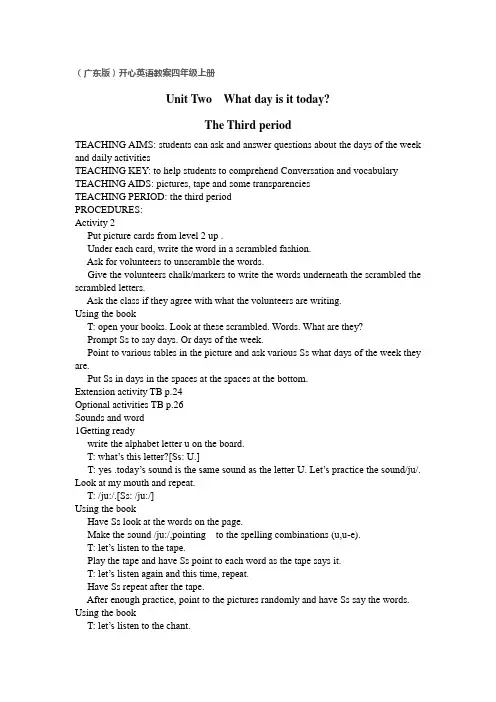
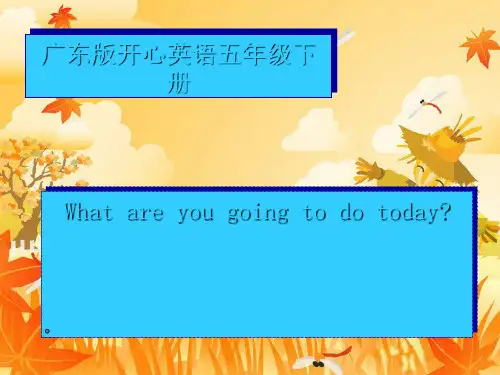

Unit2 第3课时公开课教案【广东珠海】授课教师:珠海市香洲区夏湾小学黄玲一、学情分析本课的教学对象是三年级的学生,学生好奇心强,喜欢模仿,爱玩游戏,乐于与人交流。
学生能根据教师的指令做动作、根据图片、词语和例句的提示,做简短的描述。
学生已经掌握了基本的问候语、颜色和动物的单词,学生能简单的谈论颜色,如:“What’s this? It’s a dog.” “What color is it? It’s red.”。
这些知识为本课的学习奠定了基础。
二、教学内容分析本节课是广东人民出版社《英语》三年级下册Unit2 Colors的复习课。
主要复习颜色的单词、字母p的发音和谈论颜色的句型“What color is it? It’s….”。
根据学生实际,我结合本单元知识点,拓展学习内容,让学生能用“It’s _____and ______.”描述一种物体的多种颜色,并能用“Is it…? Yes, it is./No, it isn’t.”猜测颜色和“I like….”描述自己喜欢的颜色。
1. Words: red yellow blue green purple orange brown white black2. Sounds and words: pink purple pen panda3. Patterns: What color is it? It’s…. Is it…? Yes, it is. / No, it isn’t.三、整体设计思路我结合教学内容以“A journey of finding colors”为主题,利用现代教育技术,设计了学生帮助米奇为了让失去颜色的妙妙屋恢复颜色,踏上寻找颜色之旅的主题语境。
通过任务型教学,让学生在color tunnel、color mixing room和colorful house 通过参与歌谣说唱、混色竞猜、情景对话和主题写作等一系列听、说、读、看、写的活动任务,感知、理解、体验的过程中习得和运用语言。
Unit1 第1课时参考教案一、教学内容广东人民开心学英语(三年级||起点)三年级||下册Unit1 Big or Small二、教学过程建议(一)热身导入1. Greetings.2. 引入新知.T: (Smile and look happy )I ,m your new friend. I ,m happy, I ,m big, and you ,re small.(二)任务呈现1. Song.(1) Sing the song.T: (Point to the pictures on Sb p.11) Look at our friends Boomer, is he happy? How about bonnie? Let ,s listen to a song first.播放P11歌曲给学生听.Sing after the teacher/ tape.Sing the song together/ in groups/ …(2) Learn from the song.T: Can you tell me "Are you happy?〞? Ss: Yes, I am. (No, I ,m not. )T: OK! Let ,s ask your partner.分别出示卡片sad、tall等,引导学生用"Are you …?〞去问,并学习新单词.(三)课文学习1. Game to consolidate: Show some pictures of new words. Ss try to say out quickly.2. Finish Practice13. Finish Practice2 (on Sb p.10).(四)训练稳固(1) Lead in: Today, Gogo, Tony and Jenny play outside. Look, are they happy?(2) Look at the picture (on Sb p.9), and listen to the tape twice.(3) Try to read the target.解释复数人称与are的搭配.(4) Read in three big groups to read Target.(5) Read in groups of three.(五)任务完成1. Model dialogue(根据动词提示):(走到一位学生面前)T: Hello! S1: Hi! 或Hello!T: I ,m Miss Luo. Look at me. (做冷的动作) S1: Are you …?Ss: Yes, I am. / No, I ,m not.T: (拉着一位学生,做开心动作) S1: Are they …?Ss: Yes, they are. / No, they aren ,t.2. Group work.3. Ask some groups to act out.4. Brief summarize what we learned this lesson. If there ,s time, read it.(六)布置作业Unit1 第2课时参考教案一、教学内容广东人民开心学英语(三年级||起点)三年级||下册Unit1 Big or Small二、教学过程建议(一)热身导入1. Greetings.2. Sing the song on P11.3. Daily talk. (T -S1/S2/Ss…)Are you (happy)?4. Review the words: happy, sad, tall, short, hot, cold, big, small(二)任务呈现1. Lead in.T: Look! Tony, Jenny and Gogo are in the park. They ,re very happy. Let ,s watch the video and listen the story carefully.(三)课文学习1. Watch the story twice.2. Show pictures one by one. Ss try to guess/ remember their words. Then read out. If they don ,t know the words, listen to the computer. Then repeat.3. Read the story. And fill the blank on ppt.I ___ big. You ___ big. Jenny ___ small. She ___ small.They ___ big. We ___ big. He ___ sad. He __ happy.4. 学习语法歌谣:I am, you areHe ,s, she ,s, it is,复数所有都用are .(四)训练稳固1. Practice1.(1) Listen and number.(2) Check the answer. (Ss should say out the sentences.)2. Activity 2.(1) Look and say(2) Ss say out the sentences(3) Match and say the sentences to the partner.(五)任务完成1. Brief summarize what we learned this lesson. If there ,s time, read it.(六)布置作业Unit1 第3课时参考教案一、教学内容广东人民开心学英语(三年级||起点)三年级||下册Unit1 Big or Small二、教学过程建议(一)热身导入1. Daily talk:Are you (happy)? Yes, I am. / No, I ,m not.2. Sing the song "I ,m happy!〞.(二)任务呈现1. Look at the word "happy〞, pay attention on "h〞and "a〞.(三)课文学习1.Learn the sounds /h/, /æ/, /g/, /t/.(1) Write the word "happy〞on the board.(2) T: What ,s the word? Ss: It ,s (happy).T: Do you know what is the letter "h〞,s pronunciation. Let ,s practice the sound /h/. Look at my mouth and repeat.(3) Write some words with the letter "h〞on the board, like "hello〞, "hat〞…(4) Use the same way to teach sounds /æ/, /g/, /t/.2.Practice(1) Practice the sound after the tape.(2) Practice and chant:/h/, /h/, /h/, happy/h/, /h/, /h/, hello(3) Use the same way to chant sounds /æ/, /g/, /t/.3. Writing.(1) Read the words with the partner.4. Game: Big, big eyes(1) Show the letters on the PPT quickly and let Ss read the letters correctly and quickly.(2) Pair work: Point and read the letters.(四)训练稳固1. 让学生说出一些学过含有字母h , a , g和t的其他单词.2. 选取?学辅?等学习辅助材料中重点练习快速完成并评讲.(五)任务完成1. Brief summarizes and read the new words.(六)布置作业Unit1 第1课时参考教案一、教学内容广东人民开心学英语(三年级||起点)三年级||下册Unit2 Colors二、教学过程建议(一)热身导入1. Greeting and free talk.(二)任务呈现1. Play a game - - - -Find the differences(1) Green pencil and red apple(2) Red sun and yellow sun由此引出red and yellow2. 颜色变化.两种不同颜色相加后会变成另外一种颜色,由此引出orange and blue .(1) blue + yellow = ? ( green )(2) red + yellow = ? ( orange )(3) red + blue = ? ( purple )3. T shows different colors,Ss read them.(三)课文学习(1) T take out a carrot and ask, "What ,s this?〞Ss: It ,s a carrot.T: What color is it?Ss: It ,s orange.(2) T: Look, what ,s this?Ss: It ,s an apple.T: What color is it?Ss: It ,s red.(3) Listen to the target.(4) Rainbow - - - - - -What color is this?a. It ,s red.b. It ,s red and yellow.c. It ,s red, yellow and blue.d. It ,s red, yellow, blue and green.5. Listen and sing the song Red, yellow, blue and green(四)训练稳固1. Happy cube.T show a cube with different colors.T: What color is this?Ss: It ,s …2. Practicea. The apple is _________.b. The orange is _________.c. It ,s __________.d. We must stop when the traffic light is _________.e. We should put the bottle into the __________ bin.3. Find the rules.(五)任务完成1. Group work: What color is this? It ,s…2. 教师根据学生的学习情况使用句型:What color is this? It ,s… 练习学生发音不太好的单词并及时纠正学生的发音.(六)布置作业1.听Unit2 V ocabulary& Target 录音,并跟读.2.抄写Unit2V ocabulary单词三遍.3.找出家里不同颜色的物品,使用本节课所学句型与爸爸妈妈进行练习.4.预习Unit2 Story和Target .Unit1 第2课时参考教案一、教学内容广东人民开心学英语(三年级||起点)三年级||下册Unit2 Colors二、教学过程建议(一)热身导入1. Greeting2. Sing the song Red, yellow, blue and green.(二)任务呈现1. T show a picture of paint: What , this?Ss: It ,s paint.T: Can you paint?Ss: Yes, I can. / No, I can ,t.T: OK. Do you want to know whether Gogo can paint or not?Ss: Yes.T: OK, let ,s go and see.(三)课文学习1. Listen and answer the question: Can Gogo paint? Why or why not?2. Listen and repeat the story.3. Have Ss act out the dialogue.(四)训练稳固1. Review each word in the pictures.T: What ,s this? (Point to each picture)Ss: It ,s a/an …2. T point to each picture and tell Ss the corresponding letter and number, e.g. B1 for green fish, C4 for blue whale, etc.3. T chooses one picture.4. T tells Ss to guess what animal you are thinking of by calling out questions such as Is it green? Is it a fish?5. T answer with the pattern: Yes, it is. / No, it isn ,t.6. When Ss guess your picture, they call out the grid correspondents, e.g. C3, B4, etc.7. Have Ss play this game in pairs.(五)任务完成1. Retell the story together.(六)布置作业1.观看Unit2 Story课文动画,并跟读课文.2.与自己的小伙伴或者是爸爸妈妈分角色朗读课文.3.预习Unit2 Sounds and words局部.Unit2 第3课时参考教案一、教学内容广东人民开心学英语(三年级||起点)三年级||下册Unit2 Colors二、教学过程建议(一)热身导入1. Greeting.2. Song: Red, yellow, blue and green.(二)任务呈现1. Review each word in the picture and the words of colors.T: What ,s this?Ss: It ,s a banana.T: What color is it?Ss: It ,s yellow.(三)课文学习1. Write the "banana〞on the blackboard.2. T point to the letter y and say /j/.Ss: /j/.T: /j/ /j/ yellow.Ss: /j/ /j/ yellow.T: /j/ /j/ you.Ss: /j/ /j/ you.2. Let Ss say more words with letter "y〞.3. Continue in this way with "r〞and "p〞.4. T circles "y〞, "r〞, "p〞on the blackboard and have Ss circle the letters in their books.5. Listen and read after the video.(四)训练稳固1. Play a game: T says letters, Ss say pronunciations.2. Look and write.(1) Look and copy painting on P19 of the book.(2) Copy twice of the words: yellow red pink(五)任务完成1.Read the words together.(六)布置作业1.观看Unit2 Sounds and words动画,并跟读单词.2.抄写Unit2 Sounds and words单词三遍.3.预习Unit3 V ocabulary & Target局部.Unit3 第1课时参考教案一、教学内容广东人民开心学英语(三年级||起点)三年级||下册Unit3 My room二、教学过程建议(一)热身导入1. Greetings2. Revision:3. Sing a song:"This! That! This! That! This is a red balloon! Red balloon! That is a blue balloon! Blue balloon! This! That! This! That!〞(二)任务呈现1. Presentation of wordsa. (气球飘到屋前)Gogo: What ,s that? Tony: It ,s a balloon.Gogo: What ,s that? Tony: It ,s a window.……Gogo: What ,s that? Tony: It ,s a door.b. (Gogo and Tony come into the room)Gogo: Why is empty? Tony: No. I can do magic. Gogo, look!Gogo: What ,s that? Tony: It ,s a lamp.Gogo: What ,s that? Tony: It ,s a bed.Gogo: What ,s that? Tony: It ,s a clock.Gogo: What ,s that? Tony: It ,s a pillow.c. (Gogo shows magic to change the room.)T: Do you remember what things there are in Tony ,s room?(三)课文学习1. T shows pictures about words and let Ss repeat one by one.2. T: What ,s that? ( show the picture of a bed)Ss: It ,s a bed.3. Repeat new word "a bed〞.4. Choose some students to read this word.5. Use the same way to teach "a window, a door, a clock, a lamp, a pillow〞.6. T shows the picture of pillow and ask "What ,s that?〞Ss: It ,s a pillow.T: What color is it?Ss: It white.7. Repaet word: white.8. Teach word: black.9. Game: Flash cards.(四)训练稳固1. Look at T ,s picture, ask and answer.2. Do a guessing game.3. Pair work4. Listen and number. (P.22 Practice1)(五)任务完成1. Listen and chant. (P23 Chant)(六)布置作业1.听Unit3 V ocabulary &Target录音,并跟读.2.把本单元所学的单词抄写在便利贴上,然后贴在家里相应的物品上面.3.预习Unit3 Story课文.Unit3 第2课时参考教案一、教学内容广东人民开心学英语(三年级||起点)三年级||下册Unit3 My room二、教学过程建议(一)热身导入1.Greetings.2. Chant.3. What ,s in the chant? Can you find them?(二)任务呈现1. Review the sentence: What ,s this? Is this a ___?2. Tony is very happy, because he finds Gogo. He opens the door. Let ,s see.(三)课文学习1. Listen the story.2.Do Exercise Book.3.Check the answer.4. Can you find the sentences you can ,t read?5. Teach new sentences.6. Read the sentences one by one.7. Read the story.(四)训练稳固1. Practice the sentence2. Role acting.(五)任务完成1. Look and write.Hello, I ,m Gogo. It ,s a blue desk.It ,s a _____ _____.It ,s a _____ _____.(六)布置作业1. 观看Unit3 Story课文动画, 并跟读课文.2. 与自己的小伙伴或者是爸爸妈妈分角色朗读课文.3. 预习Unit3 Sounds and words局部.Unit3 第3课时参考教案一、教学内容广东人民开心学英语(三年级||起点)三年级||下册Unit3 My room二、教学过程建议(一)热身导入1. Sing a song2. Review the sound in Unit 1 and Unit 2.(二)任务呈现1. Show the sound of letter "Ll〞, and then teach the words lamp and lion2. Show the sound of letter "Dd〞, and then teach the words door and desk3. Show the sound of letter "Ww〞, and then teach the words window and watch4. Practice reading the words.(三)课文学习1. Read the words and sounds in group2. Missing game3. Listen and number.4. Say out more words with the sounds.(四)训练稳固1. T teach how to write the words one by one.2. Ss trace the words on the book.(五)任务完成1. Watch the video and repeatthese words together.(六)布置作业1.观看Unit3 Sounds and words动画,并跟读单词.2.抄写Unit3 Sounds and words单词三遍.3.预习Unit4 V ocabulary & Target .Unit1 第1课时参考教案一、教学内容广东人民开心学英语(三年级||起点)三年级||下册Unit4 Fruit二、教学过程建议(一)热身导入1. Lead inT: We know today is Gogo ,s birthday. We are going to his birthday party. We will take some fruits for him. You are divided into 3 groups now. I want to see which group will do the best, if you are the best you can win the fruits. Are you ready? Let ,s go!2. ReviewT: Look, here is Gogo ,s home. Tony and Jenny are coming. They bring some fruits for Gogo.What are these?Ss: They ,re… (apples)T: Are these…?Ss: …(二)任务呈现1. Enjoy the PPT of fresh fruit2. a banana / bananasT: Now, they want to make some Fresh Fruit. Tony likes bananas. But there are no bananas. Gogo can help him. Look, Gogo has a magic tree.T: Look, what are these?Ss: They ,re bananas.T: A banana(points to one banana).Ss: A banana.T: Two bananas (points to two pineapples).Ss: Two bananas.T: What are these?Ss: They ,re bananas.3. A pear / pearsT: Now, they have bananas. But Jenny likes pears. Can Gogo ,s magic tree grow pears? Let ,s see. Before this, you should say:Pears, pears, they ,re pears.T: Pears.Ss: Pears.T: Pears.Ss: Pears.T: Are these Pears?Ss: Yes, they are.T: A pear.Ss: A pear.T: A pear.Ss: A pear.T: A pear.Ss: A pear.T: It ,s a pear.Ss: It ,s a pear.T: It ,s a pear.Ss: It ,s a pear.(三)课文学习1. Find the rule about these words from single form to plural form.2. Use the same way to teach the following words: an orange / oranges; a peach /peaches; a grape / garpes; a watermelon/ watermelons.3. Play a game: practice words: a banana / bananas; a pear / pears; an orange / oranges;a peach / peaches; a grape / garpes; a watermelon/ watermelons.4. T: What ,s this? (T shows the picture of cherry)Ss:It ,s a cherry.T: It ,s a cherry.Ss: It ,s a cherry.T: It ,s a cherry.Ss: It ,s a cherry.T: Cherry.Ss: Cherry.T: Cherry.Ss: Cherry.T: A cherry, two...(show pictures of some cherries), two cherries.Ss: Two cherries.Find the rule about this word from single form to plural form.Practice a cherry and cherries.T: What ,s this? (Show the picture of a strawberry.)Ss: It ,s a...T: A strawberry.Ss: A strawberry.T: A strawberry.Ss: A strawberry.T: What ,s this?Ss: It ,s a strawberry.T: What ,s this?Ss: It ,s a strawberry.T: What are these? (Show the picture of some strawberries.)Ss:...T: Strawberries.Ss: Strawberries.T: Strawberries.Ss: Strawberries.Play a game to parctice words: a cherry / cherries; a strawberry / strawberries.2. Learn to sing the song. (P29)(四)训练稳固1. Do Practice 1. Listen and number. Check the answers.2. Show Ss picture cards or a few kinds of real fruit ,and then hide them in paper bags. Point to each bag and ask "What are these?〞Ss answer "They ,re (strawberries)〞. Change the order of the bags. Hold up each bag and ask Are these (strawberries)? Ss answer "Yes, they are.〞or "No, they aren ,t.〞Reveal the fruit.(五)任务完成1. Flash cards. (T shows pictures, Ss read new words.)(六)布置作业1. 听Unit4 V ocabulary & Target 录音,并跟读.2.抄写Unit4 V ocabulary单词三遍.3.与自己的小伙伴一起练习Unit4 Target对话.4.预习Unit4 Sounds and words 局部.Unit4第2课时参考教案一、教学内容广东人民开心学英语(三年级||起点)四年级||下册Unit4 Fruit二、教学过程建议(一)热身导入1. Greetings and Free talk: Good morning! How are you? Are you happy? Is Gogo happy? Today is Gogo ,s Birthday. Sing a birthday song for Gogo. Let ,s see Gogo how to spend his birthday. In the morning, he wants to buy some fruits with Jenny at the Fruits Market.2. Song: A birthday song3. Let ,s watch the conversation to see what fruits does Gogo like?4. Watch Pictures and review the words: apples, bananas, these, those.(二)任务呈现1. Go on to learn the story and practice the key sentences.2. Teach the sentence: ‘Don ,t touch, Gogo. , To surf the Internet and collect the information to teach the students don ,t touch the dangerous things.3. Play the VCD pausing after each sentence to have Ss repeat.4. Put Ss into groups of three.S1 takes the role of Gogo, S2 takes the role of Jenny and S3 is the shop assistant5. Have Ss act out the dialog.(三)课文学习(四)训练稳固1. Put the Picture Cards on the wall or board. With a soft ball or object ,walk around the roomGently toss the object towards a card and ask the Ss questions about that card. Elicit responses.Give the object to a student and have him/her toss it at a card and ask you a question about it.2. Listen and answer the questions. Play the VCD ,pausing between the questions and have Ss answer. After listening and answering questions ,encourage Ss to ask these four questions to other Ss in pairs or small groups.(五)任务完成1. Tell Ss to draw pictures of apples ,pears or watermelons on separate sheets of paper. Have Ss lay their pictures out around the room face down on the floor. Make circles around the cards with jump ropes. Ss hop from one circle to another until T says Stop. Point at the cards and ask Ss "What are these?〞Ss try to guess what cards they are standing on by making a sentence, e.g. They ,re (pears). Ss turn over their cards to check their answers. Ss start hopping again and continue playing.(六)布置作业1.观看Unit4 Story课文动画,并跟读课文.2.与自己的小伙伴分角色练习Unit4 Story课文对话.3.预习Unit4 Story课文.Unit4 第3课时参考教案一、教学内容广东人民开心学英语(三年级||起点)三年级||下册Unit4 Fruit二、教学过程建议(一)热身导入1. In the evening, Gogo has a boxing party with his friends. Do you know boxing party? Do you want to join the party?Ss: Yes. /Yeah.2. Sing a song: What are these?(二)任务呈现Activity 1Have each student draw and color one kind of fruit on a piece of paper. Tape the papers on the floor in a straight line. For a large class, make two or more lines of papers 1 tosses a coin onto one of the papers.S1 asks "What are they?〞The other Ss answer "They age (red cherries)〞. Have the Ss stand further away from the papers and see how far they can toss the coin.Activity 2Put Ss in pairs or small groups. Model taking two minutes to look at the items on the page, closing the book and trying to remember as many pictures as possible. The Ss then do the same in their groups and write down as many things as they can remember. Compare groups , answers and see which group remember the most items, their color and their quantity.(三)课文学习Sounds and words1. Have Ss look at the pictures on the page. Listen to the VCD. Have Ss point to each Word. Listen again, and this time, repeat. Have Ss repeat after the CVD. After enoughpractice, point to the pictures randomly and have Ss say the words. Help Ss if they have difficulty making the sounds /m/, /n/, /b/.(四)训练稳固2. PracticeRead the words with the sounds. Let the students have a match. Which team read the best.Let ,s do another exercise: Listen and circle the words.3. Story time.(五)任务完成1. Make a chant.(六)布置作业1.观看Unit4 Sounds and words动画,并跟读.2.抄写Unit4 Sounds and words局部单词三遍.3.预习Unit5 V ocabulary & Target .Unit5 第1课时参考教案一、教学内容广东人民开心学英语(三年级||起点)三年级||下册Unit5 Clothes二、教学过程建议(一)热身导入1. Greetings.T: Hello, boys and girls!Ss: Hello, Mr. Zhou.T: Nice to meet you!Ss: Nice to meet you, too.T: How are you today?Ss: I ,m fine, thanks.T: Ok! Boys and girls, today we ,ll learn Unit 5 Clothes. (Write the title.)T: Boys and girls, do you know about "clothes〞? Ok, let ,s remember Tony ,s room. What ,s in Tony ,s room? Let ,s see. There are some clothes in the room. What are they? They ,re shirt, jacket, pants and socks. All these things are clothes.T: Can you tell me the meaning of "clothes〞?(二)任务呈现1. T: In Tony ,s room, there are many clothes. Where are they? Let ,s come intoTony ,s room and see. (Play the PPT)T: What ,s this?S1: It ,s a T -shirt (please listen)T: And what ,s that? S2: It ,s a jacket. ( Please listen.)T: Where ,s the jacket? It ,s on the bed. (PPT演示)(三)课文学习1. Write and teach the new words and sentences one by one. Then chant together like this: on, on, on the bed; - - -on, on, on the book; on, on, on the desk; on, on, on the chair…After that, let ,s practice these sentences with the students:Where is my…? It ,s on the …2. T: Look, what are these? They ,re socks. (listen)T: And where are the socks? They ,re in the box. (PPT演示)Then teach the new words and sentences. Attention "a sock - - -socks〞, where are my socks?3. Chant together like this: in, in, in the box; - - -in, in, in the desk; in, in, in the bag; in, in, in the pencil -box…After that, let ,s practice these sentences with the students:Where are my…? They ,re in the …4. T: Look and listen for the last picture Page 36. Tony! Where are your pants? (Repeat again.)T: Where are Tony ,s pants? Let ,s help Tony find them. Tony, Tony, where you ,re your pants? Oh! They ,re under the bed. (Show PPT) Then read and learn the newwords together. Let ,s chant like this again: under, under, under the bed, under, under, under the desk, under, under, under the chair…After that, let ,s practice these sentences with the students:Where are my…? They ,re under the …5. Do actions about these position words: on, in, under. Then ask some students to do actions, try to remember these words.6. T: Look, who ,s he?S3: He ,s Gogo.T: Where is Gogo? Is he on /in/ under the box?Ss: No, he isn ,t. He ,s between the boxes.Use the same way to teach the new word, Make some examples to let the students to understand the meaning of "between〞:T: Where is the cat? (show the pictures )Ss: The cat is between the desk and the chair.(四)训练稳固1. Play a guessing game: Show some pictures of the new words or do actions, Then Ss try to say out the words quickly.2. Let ,s sing a song together. Page 39 Socks!3. After singing, show the pictures of the song and ask Ss to answer:T: Where are my socks? Ss: They ,re in /on/ under the…4. Show some other pictures and practice with the students:T: Where is the …? Ss: It ,s …T: W here are the …? Ss: They are …5. Target:1) T: Boys and girls! Look, who ,s she? Ss: She ,s Jenny.T: Do you want to know about Jenny ,s room? What clothes are in Jenny ,s room? Let ,s come into and see. And tell me the answers: Q1: Where ,s Jenny ,s skirt?Q2: Where are Jenny ,s socks? Ok! Let ,s listen and watch the target.2) After listening, check students , answers. Then teach the new word of "skirt〞. Compare: "shirt〞and "skirt〞.3) Read the target after the teacher twice. Then read these sentence in 4 people group.4) Read and act out the target in groups.(五)任务完成1. Practice1:1) T: Open the books, turn to P38. (Practice1)Let ,s look and read these pictures one by one, try to guess "What are they saying?〞Then catch the key words.2) Listen and number these pictures:3) Repeat all these contents and check the right answers.(六)布置作业1. 听Unit5 V ocabulary & Target录音, 并跟读.2. 抄写Unit5 V ocabulary 单词三遍.3. 与自己的小伙伴或者爸爸妈妈一起练习Unit5 Target局部对话.4. 预习Unit5 Story 课文.Unit5 第2课时参考教案一、教学内容广东人民开心学英语(三年级||起点)三年级||下册Unit5 Clothes二、教学过程建议(一)热身导入1. Greetings.2. Sing the song on P39.3. Review the words and sentences:1) Look and guess the words.2) Listen and try to remember the sentences.(二)任务呈现1. Lead in.T: Look! Who ,s he? He ,s Tony. Where ,s Tony? He is at home. And Gogo comes his home. What happened to Tony?(三)课文学习1. Watch the story once and answer: Tony doesn ,t find out and put on his pants.2. Watch the second time with these questions:1) Where ,s the book? 2) Where are the pencils?3) Where are the socks? 4) Where are the pants?3. Show pictures one by one. Ss try to guess/ remember these words. Then read out. If they don ,t know the words, listen to the computer. Then repeat. (学习Good morning, class. Open your books, please.)4. Read the story together - - - groups - - - -pairs.5. Have role play in 4 people group.6. Act the story.(四)训练稳固1. Practice2.(1) Listen and answer.(2) Check the answer. (Ss should say out the sentences.)(3) Ss try to write the right answers on the books.2. Activity2.(1) Let ,s play a game with Gogo and Tony. Please look at the picture on P40. Talk about these things and where are they?(2) Can you make a question with "where〞? And how to answer?For example: Where is the clock? It ,s on the table.(3)Let the students ask and answer in pairs:(4)Check some pairs to talk about them.3. Activity1.(1)Look, read and match on P39:(2)Try to understand the meanings of all these sentences.(3)Ask some students to match and check the right answers.(五)任务完成1. Brief summarize what we learned this lesson. If there ,s time, read it.(六)布置作业1.听Unit5 Story课文动画, 并跟读课文.2.与自己的小伙伴或者爸爸妈妈一起练习Unit5 Story课文对话.3.预习Unit5 Sounds and words局部.Unit5 第3课时参考教案一、教学内容广东人民开心学英语(三年级||起点)三年级||下册Unit5 Clothes二、教学过程建议(一)热身导入1. Sing a song: Socks!Let students sing the song together.2. Review the words and sentences:(1) Make a situation: I ,m Gogo. Today ,s my birthday,I get so many presents. I ,m so happy.(2)Ask and guide students answer the questions.Where ,s the . . . ? It ,s . . .Where are the . . . ? They ,re . . .(3) Guide the students to ask and answer the questions.(二)任务呈现1. Show some pictures and lead out the words:T: What ,s that? S: It ,s a jacket.Then pay attention the sound: j[j]Let ,s read and feel these sound one by one.Then check some students to read them.T: Where is the pencil? ( show pictures)Ss: It ,s on /in /under the box.Then pay attention the sound: u[ʌ], i[i], o[o]Let ,s read and feel these sounds one by one.Then check some students to read them.3. Use the same way and lead out the other words:juice [j], uncle [ʌ], tennis [i] , dog [o]4. Let ,s make a new chant like this:[j] [j] - - -jacket, [j] [j] - - -juice;[ʌ][ʌ] - - -under, [ʌ][ ʌ] - - -uncle;[i] [i] - - -in, [i] [i] - - -tennis.[o] [o] - - -on, [o] [o] - - -dog.Then chant group by group.(三)课文学习1. Use the song and chant to teach and practice the words.2. Listen to the words and read after the tape.3. Try to find more words like these sounds:[j] - - -jump, Jenny, jeep, jelly…[ʌ] - - - umbrella, unhappy…[i] - - - is, it, this, big, six…[o] - - - hot, not, soccer…(四)训练稳固1. Look at the teacher ,s mouth and guess the words:2. Listening exercise: listen and circle the words.3. Listen and number the words:Jacket ( ) under ( ) in ( ) dog ( ) Juice ( ) uncle ( ) tennis ( ) on ( ) Then check the right answers together.4. Look and write the words on the books P41.(五)任务完成1. Brief summarizes and read the sounds and new words.(六)布置作业1.观看Unit5 Sounds and words动画, 并跟读.2.抄写Unit5 Sounds and words 单词三遍.3.预习Unit6 V ocabulary & Target .Unit6 第1课时参考教案一、教学内容广东人民开心学英语(三年级||起点)三年级||下册Unit6 Outdoor Fun二、教学过程建议(一)热身导入1. Greetings.2. 激活学生已有知识.T: Do you like baseball? S: Yes, I do.板书Do you like baseball? Yes, I do.(二)任务呈现1. Song(1) Sing the song.T: Do you remember this song ? Do you like baseball? Let ,s sing it together 让学生一起把这首||歌复习一次T: Today, we learn a new song. 播放P45的歌曲Sing after the teacher/ tape.Sing the song together/ in groups/ …(三)课文学习1. Learn from the song.T: Can you tell me "Do you have a fork now〞?Ss: Yes!T: OK! Let me ask you.分别出示a fork, a spoon, a knife, a plate, a glass, a bowl的实物,引导学生用"Do you have a____? Yes, I do. / No, I don ,t. 用以上方法学习并板书:Do you have a ______? Yes, I do.No, I don ,t. I have a ______.2. Group work.3. 出示two bowls ,然后问学生How many bowls are there? Two. 然后板书two bowls, 接着问学生T: Do you have bowls?Ss: Yes, I do.用这个问答形式,学习plates, chopsticks, knives, glasses, spoons, forks4. Group work.(四)训练稳固1. Game to consolidate: Show some pictures of the words. Ss try to say out the words.2. Practice1.(1) Point to picture AT: what do they have? Are they chopsticks? What color are they?Generate responses and do the same for the other three pictures.(2) Use the bookT: now, let ,s listen.Play the disc for number 1, then pause.T: Which picture is it? Is it B? Is it A?While Ss are responding, gradually move your hand to Picture A.T: A is number a. Write the number 1 in the box.Continue with the other three, pausing after each one.3. Target.(1) Pass out some of the picture cards. Have Ss hold up their cards and pose questions to them about their card.T: Do you have plates?S1: No, I don ,t. I have glasses.T: Does she have glasses?S2: Yes, she does.[板书:Does she have forks? Yes, she does.]Using the bookPoint to the first picture and model the dialog.Point to the second picture and model the dialog。
Unit 1 Hello!一、知识与技能Objectives and RequirementsLanguageTarget: -What’s your name? -I’m Jenny.-What’s your name? -I’m Gogo.Additional: Nice to meet you.Alphabet: a , b , cVocabularyKey: hello , hi , goodbye , byeAdditional: Gogo , Tony , Jenny , Boomer , BonnieAlphabet: apple , banana , catMaterials1)Picture Cards 1-2 plus Tony,Jenny and Gogo;pictures from magazines of people waving,greeting and departing.2)What’s your name? a large piece of paper,tape,Character Cards二、情感态度与价值观:教育学生讲礼貌,会用Hello/Hi!Goodbye/Bye!等与他人打招呼。
并让学生体会到学习英语的快乐。
三、过程与方法:Lesson 1 Story & VocabularyGetting ready·Write my name on the board.·T: Hello! I’m (T’s name).·Encourage Ss to introuduce themselves. Model the sentences if necessary. ·When Ss understand what they should do,do it again to give Ss a chance to learn their classmates’names.Using the book·Before opening the book,show Picture Cards of Gogo and Tony.·Put the Picture Card of Gogo in front of your face.·T: Hello! I’m Gogo.·Do the same with the Picture Card of Tony.·T: Look(Point to your eyes.)and listen.(Put your hand to your ear.)·Play the tape and move the Picture Cards like a puppet show.·T: Now open your books.·Model opening the textbook.·Have Ss look at the page and play the tape again.·Play the tape again,but this time pause after each line to have Ss repeat.VocabularyGetting ready·With your book closed,whisper each word while pantomiming the corresponding action. ·T: Listen. Hello! Hi! Goodbye! Bye!What am I saying?·Ss try to hear what you are saying and repeat it.Whisper softly so Ss have to concentrate to hear you.·Once Ss understand,have them repeat each expression.Using the book·T: Listen and repeat. Point to each picture.·Have Ss listen and point to each pict ure repeating after the tape.Handwriting :Unit one Hello!hello,hi,goodbye,byeHello! Hi! Goodbye! Bye!Lesson 2 Target & Practice1-2ⅠTargetGetting ready·Approach one student.·T: What’s your name?·Elicit a response from S1 or model a response if necessary.·Go to S2 and do the same.·Encourage S2 to ask T’s name.(S2: What’s your name?)·T: I’m Ms.Tang.Using the book·Have Ss look at the picture.·Point to Gogo and then Tony. Model the dialog.·Point to Jenny and then Gogo. Model the dialog.·T: Listen and repeat.·Play the tape,pausing after each expression.·After listening and repeating,pick Ss and practice the dialog.Ⅱ Practice 1Getting ready·Point to the four pictures.·T: What’s this?·Elicit responses from Ss.Using the book·T: Listen .·Play the tape for number 1,and then pause.·Point to each picture with a questioning expression.·Once the Ss indentify the correct box,trace the number 1in the box with your finger. Have Ss do the same in their books.·Continue with 2,3 and 4,but let the Ss identify the correct box in their books ontheir own.Practice 2Getting ready·Write What’s your name? on the board.·Point to Ss randomly, ask their names and elicit responses.Using the book·Have Ss draw themselves in the box.·Point to Gogo.·T: Look.·T: Listen and answer.·Play the tape and have Ss respond.ⅢSongGetting ready·Point to the pictures. Point to each character and read out the name. ·Have Ss repeat after you.Using the book·T: Listen.·Play the tape.·Listen to the song a few times.·T: Point.·Demonstrate by pointing to the pictures when singing.Encourage Ss to join in singing when ready.ActivityGetting ready·Write Gogo, Tony, Jenny, Boomer and Bonnie on the board.·Point to each one and say the name out loud.·Circle the first of each name.Using the book·Have Ss look at the written names and the pictures of the characters. ·Point to the written words.·T: Look and repeat.Gogo. (Ss: Gogo.)·Continue with the next four names.·Give Ss time to match the letters with the pictures.Handwriting:What’s your name? I'm …Lesson 3 AlphabetGetting ready·Review the Alphabet chant from Do you know......?·Have Ss look at the alphabet letters.·T: Sing and point.·Model pointing to the letters in the song.(Ss sing and point to the letters.)Using the book·Point to T’s mouth.·T: Look and repeat.·Point to the letter A.·T: A. (Ss: A.)·Open your mouth wide so that Ss can see.·T: Apple. (Ss: Apple.)·Continue with the letters B and C.·Play the tape and have Ss repeat.·After enough practice,give Ss one sound and have them point to the corresponding letter.·Give Ss a word and have them point to the corresponding letter.Handariting: Aa Bb Ccapple banana catLesson 4 Revision听音标号。
小学三年级开心学英语第二册说课稿(教案)_英语说课稿一、说教材我说课的内容是小学三年级开心学英语第二册第三单元,本课是功能型的交际型的交际训练课,我借助“任务型”教学采用多样化的教学手段将听、说、玩、演、唱溶于一体,激发学生学习英语的兴趣和愿望,使学生通过合作学习体验荣誉感和成就感从而树立自信心,发展自主学习的能力,形成初步用英语进行简单日常交际的能力。
结合新课程标准和大纲提出的基础教育阶段英语课程的总体目标和具体要求我将本课教学目标设计如下:语言知识目标:1、使学生掌握表达自己喜欢与不喜欢的句型:①Do you like …?Yes , I do . ( No , I don’t . )②I like ….2、学习认读单词:soccer baseball badminton tennis basketball dodge ball volleyball ping-pong语言技能目标:①、使学生能够根据指令做动作。
②、根据图片和情境说出单词和句子。
③、在图文或场景下进行简单的英语交流和表演。
情感态度目标:通过本课学习使学生有兴趣听、说英语、背歌谣,做游戏、敢干开口,乐于模仿,在鼓励性评价中树立信心在小组活动中积极参与合作,从而意识到交流对于学习英语的重要意义。
充分利用教材和教师的多媒体教学所提供的学习资源,实现自由参与和创新,能主动与他人交流,并克服交流中的困难,使交际顺利进行。
文化意识目标:能够恰当使用英语表达自己的喜爱与不喜爱的事物、活动、各种运动等,在语言交流中交换被此情感信息。
结合教学目标的要求,我把本课的重难点设置为1、询问喜欢什么的句型:Do you like …?2、对情境进行模仿,创新。
我主要通过感知新教材——设置——灵活运用这三个主要步骤来突破教材重难点的。
在教学开始让学生以旧带新引入新知,通过对教材的了解感知新任务,并在教师用实物(各种球),头饰、图片、录音等多种媒介的感官刺激下实现对知识的体验和实践最后在真实的生活情境中运用、实现能力的发展。
(广东版)开心英语教案六年级上册Unit3 How often do you go hiking?The Second PeriodPractice 1Getting ready:a. Write How often ___________?b. T: (Point to the first picture in A.) How often does he go swimming?c. T: (Point to the second picture in A.) Can you make a question? [Ss: How often does she go ice-skating?]d. Continue with individual students with different pictures.Using the book:a. Have Ss look at the pictures for A.b. Write He ____. underneath question A on the board.c. T: ( Point to each picture.) Can you make a sentence? [Ss: He goes swimming (once a month).]d. T: Let’s listen to the tape.e. Play the tape for A, then pause.f. T: How often does he go swimming? [Ss: He goes swimming once a week.]g. Have Ss put a checkmark in the correct box.h. Repeat the procedures with the other three questions.Practice 2Getting ready:a. Have Ss look at the Q&A on the page.b. Ask two Ss to come to the front of the classroom and role-play Gogo and Tony.Using the book:a. T: (Point to the second column with swimming.) (S1’s name), can you make a question? [S1: How often do you go swimming ?]b. T: (Think and answer truthfully.) I go swimming (once a week).c. T: Now, you answer the questions. Write your answers on the top row.d. Give Ss a few minutes to answer.e. Then put Ss in groups of four to interview each other to complete the chart.Song activityGetting ready:a. Have Ss look at the pictures.b. T: (Point to the picture of Tony.) What is Tony going to do? [Ss: He’s going to go hiking.]c. Ask questions about the other pictures.Using the book:a. Ask individual Ss to read the lyrics.b. T: (Point to the blanks on the page.) There are some words missing. Let’s listen to the song and fill in the blanks.c. Play the tape and have Ss fill in the blanks.d. Pause the tape from time to time if necessary.e. T: Now, let’s sing!f. Play the tape again and have Ss practice singing together.g. Divide Ss into four groups and assign each group a verse.h. Have each group choose one group member to sing the answer part. The rest of the group sings the questions.i. Play the tape and have each group sing along.教学后记: 对于一般现在时的第三人称的动词变化,学生掌握得不太牢固,总忘记词性变化,-s。
Unit 3 My roomPeriod 1一、教学目标:1)语言知识目标:能识别熟记单词bed, pillow, door,window, clock, lamp,black, white, 能对离自己距离不同的物品进行提问,并能运用所学单词描述房间的物品及其颜色。
(句型What’s that? It’s a … .)2)语言技能目标:能够听懂会说本单元句型,并能运用这些句子进行日常对话。
3)情感态度目标:培养学生学习英语的兴趣,乐学爱学英语,并能参与活动,与他人合作,愿意在日常生活中运用英语交流。
二、教学重点:能识别熟记单词bed, pillow, door,window, clock, lamp, black, white,三、教学难点:1. 能运用What’s that?及其答语It’s a/an +颜色+物体。
2. 掌握新单词red, black, 的读音。
和让学生清楚的知道What’s this? 和What’s that ? 的区别。
四、教学步骤Step1 Warming up1 Greetings.T: Good morning, boys and girls.Ss: Good morning, Miss HuangT: How are you?Ss: Fine, thank you, and you?T: I’m fine, too. Thank you.2.Sing the song.( Red, yellow, blue and green.)3. Revise the colors. And what is this ? What color is it ?1)T:B and G, play attention. (拿起一本课本)问:What’s this? 然后帮助学生一起回答:It’s a book. 可以再提问几个学生。
2)然后指着近处的桌子问学生:What is this? 提问学生,回答:It is a desk.然后再问他:What color is it ? 回答:It’s yellow. 再重复问一遍:What’s this? 提示学生回答:It’s a yellow desk.Step2 Lead in and Show the title.1.(师指着远处的凳子问学生)What’s that? Who can tell me .提示学生可以像刚才那样答:It’s a yellow chair.2. 在黑板上板书:What’s that? It’s a yellow chair.3. T:出示红色苹果卡片What’s this?(指名回答)S: It’s an apple.T: 当询问比较远的物体呢?What’s that? (学生跟读)引导学生回答It’s a/an +物体。
T: 随机指着远处的桌子问学生:What’s that?(排火车问答,扩大参与面)4. Show the title.1)Tell a story.T: Boys and girls, do you like story?Ss: Yes.T:I’ll tell you a story about Gogo. (师在CAI上出示这些图) 我们都知道Gogo来自另外一个星球,今天,Gogo’s brother 要来地球上看望Gogo,So Gogo is very happy. Now, he’s waiting at the door. (Gogo一大早就在门前等候了。
同学们,你们想知道Gogo的弟弟喜欢Gogo的房子吗?原来,Gogo的弟弟第一次来到地球上,对很多东西都不认识,我们看看接下来发生什么事。
Look,Gogo’s brother is flying from the sky. Gogo is going to take him in the house。
这时,弟弟看到上面的窗户就问:“What’s that?”Gogo 回答:It’s a window.弟弟马上想从窗户飞进去,可Gogo说地球人都从门走进去。
弟弟朝着Gogo指的门问:“What?What’s that?”“It’s a door. It’s a brown door.”进去后,弟弟说“I’m so tired.” Then Gogo take him to the bedroom. 房间很黑,(Gogo says “It’s black. Let me turn on the lamp.”“What’s that?”“It’s a lamp”Now, the wall is white.接着弟弟跳上了床,蹦了几下,奇怪地问:“What’s that?”“It’s a bed. An d thatis a pillow. Hey, dear brother. ”这时弟弟已经在床上睡着了。
铃铃铃……,“What’s that?”“Sorry,brother. It’s a clock.”Look at this. It’s my room What can you see in the room?2)请学生描述房间里有什么,教师再用英语描述一次,问学生认识几个单词。
3)T: Do you want to know how to say these things in English? Hey, class! Today we’ ll learn Unit 3 My room.Step 3 Presentation1. T: (屏幕出现一张床)Look, What’ s that?Ss:(帮助回答)It’ s a bed.(屏幕显示单词,领读数遍)Ss跟读,齐读,拿卡片请学生读。
T: What color is it?Ss: It’ s red.T: Yes, it’s a red .(带读数遍)(让学生联系“red”的发音学拼“bed”。
)2. T: Now, what’s on the bed? It’ s a……(鼠标指着床上的枕头)Ss:枕头。
T: How to say. It’ s a pillow.(拿卡片带读单词)What color is it? It’sa red pillow.T: (屏幕出现另一个白色枕头)What color is that?Ss: 引导学生答出. It’s a white pillow.(屏幕出现“white pillow”领读数遍,学生跟读,请个别读)利用身边的其他事物操练“white”。
3.通过颜色的复习教师出示黑色的枕头问What color is it ?引出black)4.出示Ms. Black和Mary White提问:Who’s she?同时引导学生区分white 与White,black 与Black5. T: Any other things? (屏幕出现一台灯)What’ s that?Ss: It’s a lamp. (屏幕显示单词,领读数遍,学生跟读,请小组读)It’s a pink lamp.6. T: Look at next, (屏幕出现一个闹钟)What’s that?Ss: (帮助回答)It’s a yellow and blue clock.(屏幕显示单词,带读数遍,请小组读)7. T: (屏幕出现一扇门)What’ s that?Ss: It’s a brown door.(屏幕显示单词,带读,开火车读)8. T: (紧接着指着窗户问)Is that a door?Ss: No, it isn’t. It’s a window.(屏幕出现一个窗户)T: Yes, very good. It’s a window.(显示单词)What color?Ss: It’s a green window.学习pillow后让学生联系“pillow”的ow发音学拼“window” 。
(领读数遍,学生跟读,请个别读)9.滚雪球继续操练单词,打开课本听录音跟读,然后四人小组学习。
10.教师从杂志上剪下一些room的图片,发给各小组。
用图画卡片呈现新单词,T:What’s that? S: It’s a bed. (依次window, pillow, door, clock, lamp)(开火车问答,扩大参与面)11.出示一张床的图片T:What’s that?引导学生说出It’s a yellow bed.( 依次window, pillow, door, clock, lamp)12.从而引出目标答语:It’s a/an +颜色+物体。
(板书)13. Pair work: What’s that? It’s a blue…. Is that a blue…? Yes, it is.\No, it isn’t. It’s a yellow….14Listen and repeat.15.Play the CAI and have Ss repeat each word.Step 3 : Consolidation1.就单词图片展开单词游戏:抢读单词、看图猜词、换宝2.Pair work: Ask and answer (同桌互助,解答疑惑)Review the target language using real objects in the classroom. For example, point to the clock in the room and say What’s that? Ss answer It’s a (white) clock. Then point to the door? Ss answer: Yes, it is. /No, it isn’t. Put Ss in pairs to talk about the colors and the objects in the room.3.Act out (开火车展示交流,全体参与)4. 打开学生书本P23 Look, ask and answer.1)Put the Ss into pairs.2)T: Ask your partner questions. Answer in complete sentences.3)叫学生上台提问,台下学生答。
Step4 Summary:T: Boys and girls what have we learnt today?Ss: We have learnt the new words and to ask What’s that? and the answer.T: Yes, you’re so cl ever.Step6: Homework1.Read and copy the new words four times.2. Ask your parents, brother or sister What’s that?Writing on the board:Unit 3 My roomA:What’s that?B:It’s a/an +颜色+物体四、课堂作业一、根据图画写出单词。